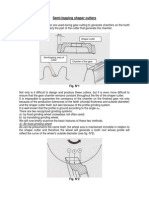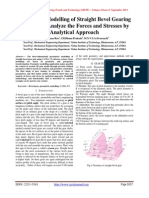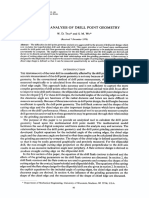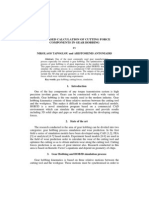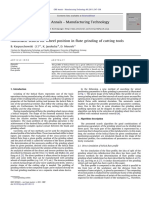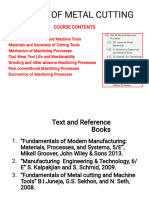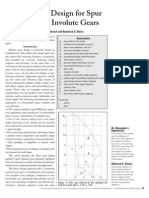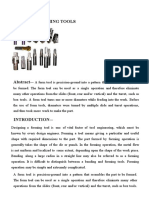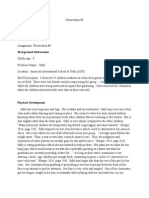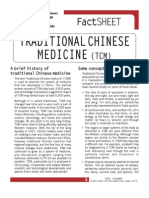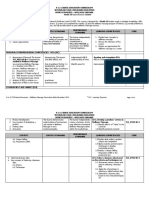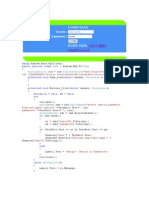Keywords: Twist Drills, Geometric Modeling, Solidmodeling Techniques
Keywords: Twist Drills, Geometric Modeling, Solidmodeling Techniques
Uploaded by
erkmorenoCopyright:
Available Formats
Keywords: Twist Drills, Geometric Modeling, Solidmodeling Techniques
Keywords: Twist Drills, Geometric Modeling, Solidmodeling Techniques
Uploaded by
erkmorenoOriginal Title
Copyright
Available Formats
Share this document
Did you find this document useful?
Is this content inappropriate?
Copyright:
Available Formats
Keywords: Twist Drills, Geometric Modeling, Solidmodeling Techniques
Keywords: Twist Drills, Geometric Modeling, Solidmodeling Techniques
Uploaded by
erkmorenoCopyright:
Available Formats
115
16
th
International Research/Expert Conference
Trends in the Development of Machinery and Associated Technology
TMT 2012, Dubai, UAE, 10-12 September 2012
GEOMETRIC MODELING OF TWIST DRILLS
Janko D. Jovanovi
1
, Obrad Spai
2
1
Faculty of Mechanical Engineering, Dorda Vaingtona bb., Podgorica, Montenegro
2
Faculty of Production and Menagement, Trg Palih boraca 1, Trebinje, BiH
ABSTRACT
Accurate geometric models of twist drills are needed to determine the required grinding wheel profile
for generating a given drill flute profile design, as well as, for finite element simulations of the drilling
process. This paper presents a method to create accurate models of two-flute conical twist drills using
analytical equations to generate drill flute profile needed for production of twist drills with straight
lips and solidmodeling techniques to generate geometric models of twist drills. Boolean operations are
used to mimic the drill manufacturing steps and generate the fully designed drill.
Keywords: twist drills, geometric modeling, solidmodeling techniques
1. INTRODUCTION
Drilling is one of the most commonly performed material removal processes, being increasingly
popular over the years. The aforementioned process is used to create a cylindrical hole in a solid
section of a work piece material. When using mechanical methods and tools, drilling involves
rotational and linear feed motions. Invented almost two centuries ago, todays twist drill is a general
purpose tool used to produce holes ranging in size from very small (0.1 mm) to quite large diameters
(well over 100mm). Although the conventional drilling tool is very common in industry, it is
characterized by a complex geometry.
Galloway [1] initiated a formal study of drill geometry in his paper where he discussed several aspects
of the drilling process and gave a sophisticated analysis of drill point sharpening based on a conical
grinding concept for straight lipped drills shown in figure 1.
Figure 1. Drill point sharpening based on a conical grinding concept
116
In this work the geometry in the vicinity of the drill lips was thoroughly studied including methods of
specifying and measuring the lip clearance angle. Equations for the relevant part of the flute geometry
required to give straight lips were derived together with expressions for lip clearance and rake angles
along the drill lips. Galloway pointed out that the flank surface of the drill would be fully determined
if the semi-cone angle , and the cone apex position with respect to the drill axis, denoted by
parameter d and s in Figure 1, were known in addition to the specified point angle 2p, web thickness
W and diameter D.
Subsequent researchers built on Galloways basic framework and extended his analytical equations to
develop computer-based models. Fujii et al. [2,3] developed algorithms to develop drill models by
computer. The drill geometry was analyzed by considering the slicing of the drill by arbitrary
planes. A computer model was also developed to design a twist drill. Vijayaraghavan et al. [4]
developed an automated drill modeling tool in Solidworks. The tool uses Solidworks to generate a 3D
model of a drill based on manufacturing parameters of the drill supplied by the user. The tool outputs
the drill in a variety of solid geometry formats which can then be meshed and used in different FE
modeling packages. Kyratsis et al. [5,6] developed software routine, which creates parametrically
controlled drill geometries and using different cutting conditions, achieves the generation of solid
models for all the relevant data involved. This routine can simulate the drilling operation using 3D
solids for both the drilling tool and the work piece. Those models were used in order to simulate the
penetration of the tool inside the work piece and subsequently led to the generation of 3D solid models
for the undeformed chip and the cut work piece [5]. This routine also calculates the thrust force of
both the cutting areas of the tool, main edges and chisel edge, simultaneously [6].
This paper deals with establishing procedure, based on Galloways approach, for development of CAD
tool for automated modeling of two-flute conical twist drills. This procedure involves analytical
equations to generate drill flute profile needed for production of twist drills with straight lips and
solidmodeling techniques to generate geometric models of twist drills which mimic the drill
manufacturing steps. Accurate geometric models of twist drills output by this CAD tool are needed to
determine the required grinding wheel profile for generating a given drill flute profile design, as well
as, for finite element simulations of the drilling process.
2. METHOD
2.1 Manufacturing of two-flute drills
Drill manufacturing consists primarily of two grinding steps, namely grinding the flute faces and
grinding the flank faces. The parameters of these grinding operations determine the geometric
parameters of the drill. Parameters such as point angle and web thickness are implicit functions of the
drills manufacturing parameters.
During flute grinding the grinding wheel rotates in-place with the drill simultaneously rotating about
and moving down its axis. The dual motion of the drill controls the helix angle of the flute and the
position and profile of the grinding wheel controls the cross-section of the drill flute. In a two-flute
drill, this is performed twice at orthogonal positions to generate both flutes. During flank grinding, the
grinding wheel rotates about a fixed axis to form a grinding cone of cone semi-angle , shown in
Figure 1, and the dill rotates in-place. This grinding is also performed twice from symmetric
positions to generate both flank surfaces. These flank surfaces can be considered as sections of the
grinding cones.
2.2 Modeling of flute faces
The cross-section of the flute is dependent on the shape of the grinding wheel used for grinding it. The
cross-section of the drill has to be designed such that it generates a straight secondary cutting edge
when the flanks are ground. Hence, the shape of the flute grinding wheel is dependent on the
specifications of the drill that is being ground. The cross-section of the flute can be divided into 6
sections, as shown in Figure 2. Sections 1 and 2 are un-ground parts of the drill-blank and are arcs
which make up a circle.
117
Figure 2. Flute cross-section
Sections 3 and 4 can be described by the following polar equation [1]:
( ) ( )
( ) p D
W r
r
W
tan
tan 2
2
arcsin
2 2
=
(1)
where r is a variable in the polar equation, and is varied from W/2 to D/2, is the helix angle. This
polar equation makes sure that the flank section produces a drill with a straight cutting edge. Sections
5 and 6 do not contribute much to the cutting performance of the drill and only need to be optimized to
provide rigidity. For simplicity, they can be modeled as symmetric to sections 3 and 4, respectively
[4].
3D solid model of flute faces is obtained when the flute cross-section is swept, i.e., rotated and
translated about its axis. The sweep matrix is given as:
=
1
2
0 0
0 1 0 0
0 0 cos sin
0 0 sin cos
P
S (2)
where
P
L
2
0 , L is the length of cylindrical fluted portion of the drill and P is pitch, which is
expressed as:
( )
tan
=
D
P
(3)
2.3 Modeling of flank faces
The vertices of the grinding cones, as shown in Figure 1, are as follows:
( )
sin tan cos
sin cos tan
=
=
+ =
d d C
s C
d d C
z
y
x
(4)
where is the angle between the projections of the cone and drill axes on a plane parallel to these
axes, which can be expressed as:
( ) = p
(5)
The upper sign in the previous equations refers to the right grinding cone, while the lower sign refers
to the left grinding cone.
Drawing the cone axes at these vertices and creating a virtual cone, with the semi-cone angle , to
performe a Boolean subrtact cut one can generate the flank faces of the drill.
118
3. RESULTS
From the above analysis, the following parameters, geometric and manufacturing, are needed to
completely describe a drill: diameter of drill, web thickness, helix angle, point angle, grinding cone
angle and Galloways parameters. A drill geometric model generated by established procedure, for the
following set of parameters d=11mm, W=1.8mm, =30
o
, 2p=118
o
, =30
o
, d=5.5mm and s=1mm, is
shown in Figure 3.
Figure 3. Generation of drill geometric model
4. CONCLUSION
The novelty of the this research is that the drill modeling procedure, that is going to be embedded in a
commercial CAD environment by exploiting its modeling and graphics capabilities, has been
established. Established procedure is based on geometric and manufacturing drill parameters and
enables producing pure 3D solid model of the two-flute twist drill. These 3D geometric definition
provide the data required for a number of downstream applications, i.e., finite element analysis, 3D
scanning of tool geometry etc.
5. REFERENCES
[1] Galloway D.F.: Some experiments on the influence of various factors on drill performance, Tranactions of
ASME, Vol.79, 1957.
[2] Fujii S., DeVries M.F., Wu S.M.: An analysis of drill geometry for optimum drill design by computer, Part
I Drill geometry analysis, Journal of Engineering for Industry, Vol.92, 1970.
[3] Fujii S., DeVries M.F., Wu S.M.: An analysis of drill geometry for optimum drill design by computer, Part
II Computer aided design, Journal of Engineering for Industry, Vol.92, 1970.
[4] Vijayaraghavan A., Dornfeld D.: Automated drill modeling for drilling process simulation, Transactions of
ASME, Journal of Computing and Information Science in Engineering, Vol. 7, No.3, 2007.
[5] Kyratsis P., Bilalis N., Antoniadis A.: CAD based predictive models of the undeformed chip geometry in
drilling, World Academy of Science Engineering and Technology, Vol. 5, 2009.
[6] Kyratsis P., Bilalis N., Antoniadis A.: CAD based simulation and design of experiments for determining
thrust force in drilling operations, Computer Aided Design, 2011.
You might also like
- Explicit Dynamics With LS-DYNADocument159 pagesExplicit Dynamics With LS-DYNACarlos Américo100% (7)
- Fanuc Robocut Α-cib SeriesDocument12 pagesFanuc Robocut Α-cib SeriesDenis AntunesNo ratings yet
- Semi-Topping Shaper CuttersDocument4 pagesSemi-Topping Shaper Cuttersalemarlonstos0% (1)
- Parametric Modelling of Straight Bevel Gearing System and Analyze The Forces and Stresses by Analytical ApproachDocument5 pagesParametric Modelling of Straight Bevel Gearing System and Analyze The Forces and Stresses by Analytical ApproachseventhsensegroupNo ratings yet
- Drill ModelingDocument13 pagesDrill Modelingantonio87No ratings yet
- Computer Analysis of Drill Point GeometryDocument14 pagesComputer Analysis of Drill Point GeometryLuis FelipeNo ratings yet
- A Manufacturing Model of An End Mill Using A Five-Axis CNC Grinding Machine - Shenyang2009Document12 pagesA Manufacturing Model of An End Mill Using A Five-Axis CNC Grinding Machine - Shenyang2009chitumoshuNo ratings yet
- CAD-based Simulation of The Hobbing ProcessDocument11 pagesCAD-based Simulation of The Hobbing ProcessGabriel MariusNo ratings yet
- A Mathematical Model For Simulating and Manufacturing BallDocument11 pagesA Mathematical Model For Simulating and Manufacturing BallYerko VillcaNo ratings yet
- Considerations On The Geometrical Elements Calculated For Circular Arc Teeth Bevel Gears, 528 Saratov TypeDocument6 pagesConsiderations On The Geometrical Elements Calculated For Circular Arc Teeth Bevel Gears, 528 Saratov Typejulio_rodriguesNo ratings yet
- Profile Correction of A Helical Gear Shaping CutterDocument11 pagesProfile Correction of A Helical Gear Shaping Cutterdanielk32No ratings yet
- Cad Based Calculation of Cutting Force Components in Gear HobbingDocument11 pagesCad Based Calculation of Cutting Force Components in Gear HobbingNikola Čegec100% (2)
- Automatic Search For Wheel Position in Flute Grinding of Cutting ToolsDocument4 pagesAutomatic Search For Wheel Position in Flute Grinding of Cutting ToolsGustavo FerronattoNo ratings yet
- Geometric End MillsDocument11 pagesGeometric End MillsRomansNo ratings yet
- Helical BroachingDocument8 pagesHelical Broachingguytr2No ratings yet
- Milling MachineDocument11 pagesMilling MachineAnil Deshpande100% (2)
- Analisis Dan Perencanaan Roda Gigi Lurus Pembawa Eretan Mesin Bubut Krisbow Tipe KW 15-178 Jusuf TalaperuDocument7 pagesAnalisis Dan Perencanaan Roda Gigi Lurus Pembawa Eretan Mesin Bubut Krisbow Tipe KW 15-178 Jusuf TalaperuIchsandz CybzNo ratings yet
- A Novel Hob Design: For Precision Involute GearsDocument11 pagesA Novel Hob Design: For Precision Involute GearsKalyan Chakravarthy100% (1)
- 3D Tool OffsetDocument28 pages3D Tool OffsetKiên Trung NguyễnNo ratings yet
- Milling MachnesDocument81 pagesMilling MachnesshafiqNo ratings yet
- Theory of Metal Cutting: Course ContentsDocument177 pagesTheory of Metal Cutting: Course Contentshassan tagNo ratings yet
- Hob IdentificationDocument12 pagesHob IdentificationParminder SinghNo ratings yet
- 11 - Chapter 2 PDFDocument20 pages11 - Chapter 2 PDFalmedin_hecimov8494No ratings yet
- Drafting TextbookDocument41 pagesDrafting Textbookgsreads470% (1)
- 1 s2.0 S0307904X1300379X MainDocument10 pages1 s2.0 S0307904X1300379X MainPradita FirmansyahNo ratings yet
- Geometrical Modeling of Rotary Milling Operation of Crankshaft PinsDocument10 pagesGeometrical Modeling of Rotary Milling Operation of Crankshaft PinsMuhammad Bachtiar YusufNo ratings yet
- Machining of Spur Gears Using A Special: Milling CutterDocument5 pagesMachining of Spur Gears Using A Special: Milling CutterSubrat BhoktaNo ratings yet
- Jakub Czy Zyc Ki KnifeDocument19 pagesJakub Czy Zyc Ki KnifeAditya AlamsyahNo ratings yet
- Research Papers: Process Centerless Recess GrindingDocument6 pagesResearch Papers: Process Centerless Recess GrindingNatKThNo ratings yet
- Visualization Process For Design and Man 221005 061931Document4 pagesVisualization Process For Design and Man 221005 061931Trung ThanhNo ratings yet
- Tool Model Building and Research On Cutting Simulation Experiment of Ti6Al4VDocument21 pagesTool Model Building and Research On Cutting Simulation Experiment of Ti6Al4VhaceneNo ratings yet
- Geometry Design Model of A Precise Form-Milling Cutter Based On The Machining CharacteristicsDocument16 pagesGeometry Design Model of A Precise Form-Milling Cutter Based On The Machining Characteristicschoprarun100% (1)
- Gear Skiving ProcessDocument8 pagesGear Skiving ProcessrethinamkNo ratings yet
- Unit 7 Design of Forming Tools: StructureDocument5 pagesUnit 7 Design of Forming Tools: Structuresudhanshumishra123352No ratings yet
- True Involute Diameter TIF SAP GearsolutionsDocument9 pagesTrue Involute Diameter TIF SAP GearsolutionsSantiagoNo ratings yet
- A Simplified 3d Model Approach in Constructing The Plain Vane Profile of A Radial Type Submersible Pump ImpellerDocument5 pagesA Simplified 3d Model Approach in Constructing The Plain Vane Profile of A Radial Type Submersible Pump ImpellerVignesh KumaranNo ratings yet
- DrawingDocument8 pagesDrawingTommyVercettiNo ratings yet
- Aug2001 - Mechanistic Modeling of The Ball End Milling Process For Multi-Axis Machining of Free-Form SurfacesDocument11 pagesAug2001 - Mechanistic Modeling of The Ball End Milling Process For Multi-Axis Machining of Free-Form SurfacesusamaumerNo ratings yet
- CAD 00 GuideSurfaceTPGDocument9 pagesCAD 00 GuideSurfaceTPGGabryel BogdanNo ratings yet
- Parametric Spur GearDocument11 pagesParametric Spur GearGoutam AcharjeeNo ratings yet
- A Study On The Ultra Precision Progressive Die Making For Sheet Metal Forming by Computer SimulationDocument4 pagesA Study On The Ultra Precision Progressive Die Making For Sheet Metal Forming by Computer SimulationGerardo ArroyoNo ratings yet
- MillingDocument37 pagesMillingAseem Goyal100% (1)
- M. Fontaine, A. Devillez, A. Moufki, D. DudzinskiDocument14 pagesM. Fontaine, A. Devillez, A. Moufki, D. DudzinskiOscar RamónNo ratings yet
- MP I SubmissinDocument7 pagesMP I SubmissinAbhijeet PramanikNo ratings yet
- Assignment No 1 (ME 461)Document6 pagesAssignment No 1 (ME 461)Jayant Raj SauravNo ratings yet
- Impeller Design of A Single Blade Hydrodynamic PumpDocument9 pagesImpeller Design of A Single Blade Hydrodynamic Pumpdavidjoshua.mmNo ratings yet
- A New Dynamic Model For Drilling and Reaming Processes Yang2002Document13 pagesA New Dynamic Model For Drilling and Reaming Processes Yang2002RihabChommakhNo ratings yet
- CH 7 MillingDocument54 pagesCH 7 MillingVirender RawalNo ratings yet
- Sheet Metal Operations of RobotDocument10 pagesSheet Metal Operations of RobotsatishnamalaNo ratings yet
- Roll Pass Design For Ribbed BarsDocument8 pagesRoll Pass Design For Ribbed BarsDiaa KassemNo ratings yet
- Simufact-A-Fastener Manufacture-Simulation of The Cold Forging ProcessDocument8 pagesSimufact-A-Fastener Manufacture-Simulation of The Cold Forging ProcessMurisa DizdarevicNo ratings yet
- Direct Gear DesignDocument7 pagesDirect Gear DesignFranco Angelo RegenciaNo ratings yet
- 3-Axis NC Tool Path Generation and Machining Simulation For Subdivision Surface of Complex ModelsDocument9 pages3-Axis NC Tool Path Generation and Machining Simulation For Subdivision Surface of Complex ModelssaaNo ratings yet
- Form Tool Design PROCEDURESDocument15 pagesForm Tool Design PROCEDURESSiddharth Dubey100% (1)
- Cutting Force Ball EndmillDocument10 pagesCutting Force Ball EndmillJosep StalinNo ratings yet
- Gear ShavingDocument6 pagesGear ShavingRuchira Chanda InduNo ratings yet
- Geometrically Accurate Computer 3D Models of GearDocument9 pagesGeometrically Accurate Computer 3D Models of GeareliretamozaNo ratings yet
- Materials Science and Technology of Optical FabricationFrom EverandMaterials Science and Technology of Optical FabricationNo ratings yet
- A Manual of Elementary Geometrical Drawing Involving Three Dimensions: In Five Divisions, Div. I. Elementary Projections Div. II. Details of Constructions in Masonry Wood, and Metal Div. III. Rudimentary Exercises in Shades and Shadows Div. IV. Isometrical Drawing Div. V. Elementary Structural DrawingFrom EverandA Manual of Elementary Geometrical Drawing Involving Three Dimensions: In Five Divisions, Div. I. Elementary Projections Div. II. Details of Constructions in Masonry Wood, and Metal Div. III. Rudimentary Exercises in Shades and Shadows Div. IV. Isometrical Drawing Div. V. Elementary Structural DrawingRating: 5 out of 5 stars5/5 (1)
- Structural Drafting - A Practical Presentation of Drafting and Detailed Methods used in Drawing up Specifications for Structural Steel WorkFrom EverandStructural Drafting - A Practical Presentation of Drafting and Detailed Methods used in Drawing up Specifications for Structural Steel WorkRating: 3 out of 5 stars3/5 (1)
- Observation 3Document3 pagesObservation 3api-272845438No ratings yet
- Device To Device CommunicationDocument19 pagesDevice To Device CommunicationabdelNo ratings yet
- Pragmatics Chapter 6Document16 pagesPragmatics Chapter 6AJ JBNo ratings yet
- STZNNNNHDHDocument4 pagesSTZNNNNHDHgiriNo ratings yet
- Kendall Sad9 Im 05Document16 pagesKendall Sad9 Im 05Andre De BeerNo ratings yet
- The Relationship Between Performance Appraisal and Job PerformanceDocument12 pagesThe Relationship Between Performance Appraisal and Job PerformanceAmit ShindeNo ratings yet
- Practice ITBS Test Math Concepts and Math EstimationDocument20 pagesPractice ITBS Test Math Concepts and Math EstimationImani BalivajaNo ratings yet
- Traditional Chinese MedicineDocument5 pagesTraditional Chinese MedicineluyawinNo ratings yet
- HTTPDocument6 pagesHTTPMikan Radenko MikanovićNo ratings yet
- Audit and AssuranceDocument53 pagesAudit and Assuranceattaullah_niazi93No ratings yet
- Fr-Paap-01. Plan OF Assessment Activities and ProcessesDocument3 pagesFr-Paap-01. Plan OF Assessment Activities and ProcessesJeon Fakar RkNo ratings yet
- Priest, Graham - The Structure of The Paradoxes of Self-ReferenceDocument11 pagesPriest, Graham - The Structure of The Paradoxes of Self-ReferenceThomas Cantor100% (1)
- Low Power Add and Shift Multiplier Design Bzfad ArchitectureDocument14 pagesLow Power Add and Shift Multiplier Design Bzfad ArchitecturePrasanth VarasalaNo ratings yet
- Explanation TextDocument22 pagesExplanation TextFiriMohammediNo ratings yet
- Advance Computer Architecture Mcq'sDocument11 pagesAdvance Computer Architecture Mcq'sGuruKPO81% (31)
- Internet Technology Lab ManualDocument9 pagesInternet Technology Lab ManualmitprasoonNo ratings yet
- (Learning Activity) (Week) (Hours / Week) (Hours / Semester)Document6 pages(Learning Activity) (Week) (Hours / Week) (Hours / Semester)Thashnee BalaNo ratings yet
- Wellness Massage For Grade 10Document11 pagesWellness Massage For Grade 10Eleuterio MontaNo ratings yet
- Formatting Instructions For NIPS 2015: David S. Hippocampus CoauthorDocument5 pagesFormatting Instructions For NIPS 2015: David S. Hippocampus CoauthorchrisNo ratings yet
- Super Robot Wars Z-2Document4 pagesSuper Robot Wars Z-2chaossang2No ratings yet
- Sara Swat Hi River ResearchDocument180 pagesSara Swat Hi River ResearchNagaraja Rao Mukhirala100% (1)
- Using Public Partial Class New Protected Void Object: Home Sqlconnection Sqlconnection EventargsDocument6 pagesUsing Public Partial Class New Protected Void Object: Home Sqlconnection Sqlconnection EventargsJulie SachanNo ratings yet
- Attention and FocusDocument9 pagesAttention and FocusTrauma Clinic LtdNo ratings yet
- Performance Appraisal Letter TemplateDocument2 pagesPerformance Appraisal Letter TemplateJohn MarkNo ratings yet
- 2025 Sun OnlyDocument57 pages2025 Sun OnlyLivius 3D PrintNo ratings yet
- B. Inggris DikonversiDocument10 pagesB. Inggris DikonversiMardi AnaNo ratings yet
- Excel Accounting Basics PDFDocument18 pagesExcel Accounting Basics PDFSpring Anderson0% (1)
- RIETAN 94 ManualDocument35 pagesRIETAN 94 ManualCarlos Andre BezerraNo ratings yet


